1 “Spes non confundit”, “hope does not disappoint” (Rom 5:5). Under the sign of hope, the Apostle Paul stimulates the courage of Rome’s Christian community. Hope will also be the central message of the next Jubilee, which the Pope proclaims every twenty-five years, in accordance with an ancient tradition. I’m thinking of all the pilgrims of hope who will arrive in Rome to experience the Holy Year, and of those who, unable to travel to the city of the apostles Peter and Paul, will celebrate it in their particular Churches. May it be for all a moment of living, personal encounter with the Lord Jesus, “the “door of salvation (cf. Jn 10:7.9). He is “our hope (cf. 1 Tim 1:1), and the Church’s mission is to proclaim Him always, everywhere and to everyone.
Everyone hopes. Hope is contained in the heart of every person as a desire and expectation of good, even though we don’t know what tomorrow will bring. The unpredictability of the future gives rise to sometimes contradictory feelings: from confidence to fear, from serenity to discouragement, from certainty to doubt. We often meet discouraged people who look to the future with skepticism and pessimism, as if nothing could bring them happiness. May the Jubilee be an opportunity for everyone to rekindle hope. The Word of God helps us to find the reasons. Let us be guided by what the apostle Paul wrote to the Christians of Rome.
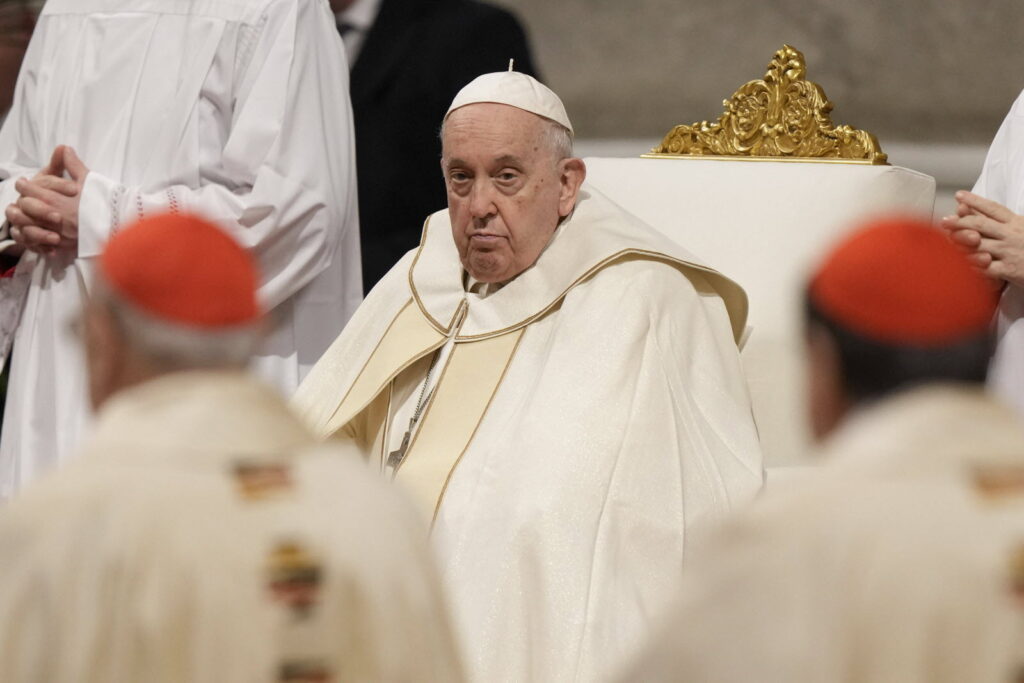
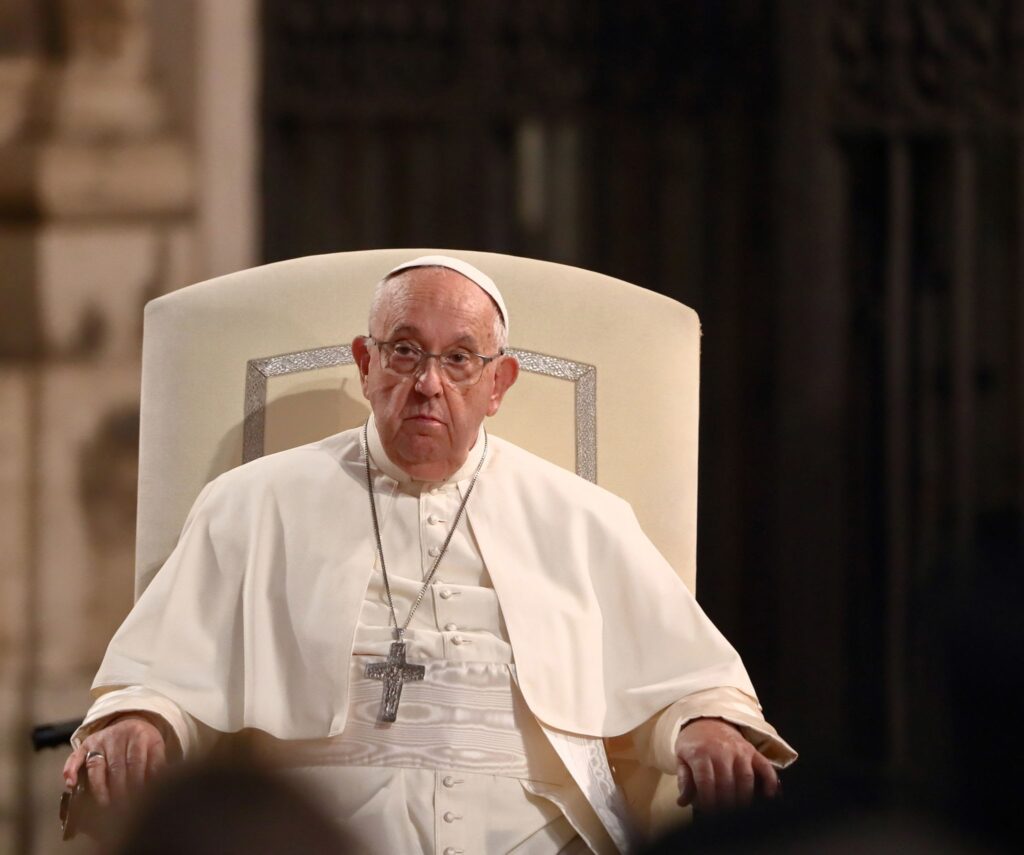
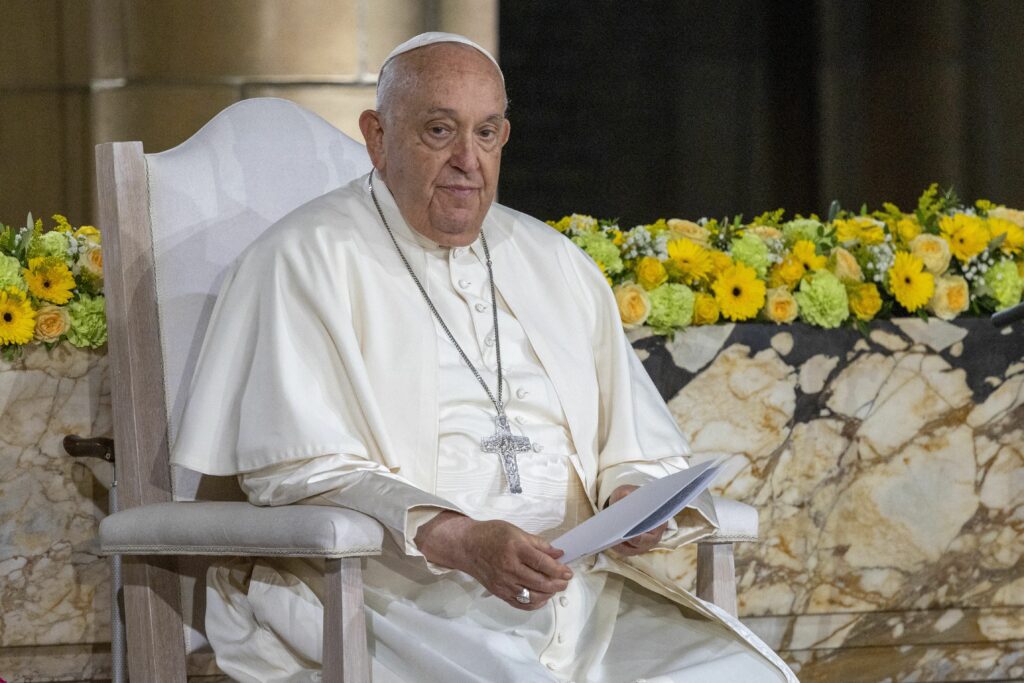
- A word of hope
2. “We who have become righteous by faith are at peace with God through our Lord Jesus Christ, who through faith has given us access to that grace in which we are established; and we put our pride in the hope of sharing in the glory of God […] Hope does not disappoint, since the love of God has been poured into our hearts by the Holy Spirit who has been given to us. […] Hope does not disappoint, since God’s love has been poured into our hearts through the Holy Spirit who has been given to us”. (Rom 5:1-2.5). There are many points for reflection here. We know that the Letter to the Romans marks a decisive stage in his evangelizing activity. Until then, he had been evangelizing in the eastern part of the Empire, and now Rome awaits him, with all that it represents in the eyes of the world: a great challenge for the proclamation of the Gospel, which can know neither barriers nor frontiers. The Church of Rome was not founded by Paul. He felt a burning desire to join it as soon as possible, to bring to everyone the Gospel of Jesus Christ, dead and risen, as the proclamation of hope that fulfills promises, leads to glory and, founded on love, does not disappoint.
3. Hope, in fact, is born of love, and is founded on the love that springs from the Heart of Jesus pierced on the cross: “For if we were reconciled to God through the death of his Son when we were his enemies, how much more, now that we are reconciled, will we be saved by sharing in his life?” (Rom 5:10). And his life is manifested in our life of faith, which begins with baptism, develops in docility to God’s grace, and is consequently animated by ever-renewed hope, made unshakeable by the action of the Holy Spirit.
Indeed, it is the Holy Spirit who, through his constant presence on the Church’s path, radiates the light of hope on believers: He keeps it burning like a torch that never goes out, giving support and vigor to our lives. Christian hope neither deceives nor disappoints, because it is founded on the certainty that nothing and no-one can ever separate us from the love of God: “What can separate us from the love of Christ? distress? anguish? persecution? hunger? destitution? danger? the sword? […] But in all this we are the great victors, thanks to him who loved us. I am certain of this: neither death nor life, neither angels nor heavenly principalities, neither the present nor the future, neither the powers, nor the heights, nor the depths, nor any other creature, nothing will be able to separate us from the love of God which is in Christ Jesus our Lord”. ( Rm 8, 35.37-39). This is why hope does not give way in the face of difficulties: it is founded on faith and nourished by charity. It enables us to move forward in life. St. Augustine writes on this subject: “Whatever the kind of life, we cannot live without these three inclinations of the soul: to believe, to hope, to love”.. [Discours, 198 augm, 2].


4. Saint Paul is a realist. He knows that life is made up of joys and sorrows, that love is put to the test when difficulties increase, and that hope seems to disappear in the face of suffering. Yet he writes: “We put our pride in distress itself, since distress, we know, produces perseverance; perseverance produces tried virtue; tried virtue produces hope.” (Rom 5:3-4). For the apostle, tribulation and suffering are typical conditions for those who proclaim the Gospel in contexts of misunderstanding and persecution (cf. 2 Cor 6:3-10). In these situations, we see a light in the darkness. We discover how evangelization is sustained by the strength that flows from Christ’s cross and resurrection. This leads us to develop a virtue closely linked to hope: patience. In a world where haste has become a constant, we’ve become accustomed to wanting everything right away. We no longer have the time to meet and often, even within families, it becomes difficult to get together and talk calmly. Patience is undermined by haste, causing serious harm to individuals. Intolerance, nervousness and sometimes gratuitous violence arise, leading to dissatisfaction and closure.
What’s more, in the age of the Internet, where space and time are dominated by the “here and now”, patience is not welcome. If we were still capable of looking at creation with wonder, we could understand how decisive patience is. Waiting for the seasons to alternate with their fruits; observing the life of animals and the cycles of their development; having the simple gaze of St. Francis who, in his Canticle of Creatures composed exactly 800 years ago, perceived creation as one big family and called the sun “brother and the moon “sister”. [Cf. Franciscan Sources, n. 263, 6.10.] Rediscovering patience does us and others a lot of good. Saint Paul often uses the word “patience” to emphasize the importance of perseverance and trust in what God has promised us, but above all he testifies that God is patient with us, He who is “the God of perseverance”. who is “the God of perseverance and comfort”. ( Rom 15:5). Patience, which is also the fruit of the Holy Spirit, keeps hope alive and consolidates it as a virtue and a way of life. So let’s learn to ask often for the grace of patience, which is the daughter of hope and at the same time sustains it.
- A path of hope
5. This interweaving of hope and patience clearly shows that the Christian life is a journey that needs strong moments to nourish and strengthen hope, the irreplaceable companion that gives us a glimpse of the goal: the encounter with the Lord Jesus. I like to think that the inauguration of the first Jubilee in 1300 was preceded by a journey of grace, animated by popular spirituality. Indeed, we cannot forget the various ways in which the grace of forgiveness was abundantly poured out on God’s holy and faithful people. Let’s recall, for example, the great “pardon” that St. Celestine V wanted to grant to those who came to the Basilica of St. Mary of Collemaggio, in L’Aquila, on August 28 and 29, 1294, six years before Pope Boniface VIII instituted the Holy Year. The Church was thus already experiencing the jubilee grace of mercy. Even earlier, in 1216, Pope Honorius III had accepted St. Francis’s supplication for an indulgence for those who visited the Porziuncola on the first two days of August. The same applies to pilgrimages to Santiago de Compostela: in 1122, Pope Calixtus II allowed the Jubilee to be celebrated at this shrine whenever the feast of the Apostle James coincided with a Sunday. It’s a good thing that this “diffuse” modality of Jubilee celebrations continues, so that the strength of God’s forgiveness supports and accompanies the journey of communities and individuals.

“Setting out on a journey is characteristic of those in search of the meaning of life”.
It’s no coincidence that pilgrimage is a fundamental element of every jubilee event. Setting out on a journey is characteristic of those seeking the meaning of life. Pilgrimages on foot are a great way to rediscover the value of silence, of effort, of the essential. Once again next year, pilgrims of hope are sure to take ancient and modern paths to live the Jubilee experience to the full. In Rome itself, there will also be itineraries of faith, in addition to the traditional routes of the catacombs and the seven churches. Transiting from one country to another as if borders had been abolished, moving from one city to another in contemplation of creation and works of art, will enable us to draw on diverse experiences and cultures to carry within us the beauty which, harmonized by prayer, leads us to thank God for the marvels He has accomplished. Jubilee churches along the itineraries and in the Urbs will be oases of spirituality where people can refresh themselves on the path of faith and drink from the wellsprings of hope, above all by approaching the sacrament of reconciliation, an irreplaceable starting point for a genuine journey of conversion. In the particular Churches, special attention will be paid to the preparation of priests and faithful for confession, and to the accessibility of the sacrament on an individual basis.
During this pilgrimage, I would like to extend a special invitation to the faithful of the Eastern Churches, especially those who are already in full communion with the Successor of Peter. They who have suffered so much – often to the point of death – for their fidelity to Christ and the Church, should feel particularly welcome in this Rome which is also their Mother and which preserves many memories of their presence. The Catholic Church, enriched by their ancient liturgies, by the theology and spirituality of the Fathers, monks and theologians, wishes to symbolically express its welcome to them, and to their Orthodox brothers and sisters, at a time when they are already experiencing the pilgrimage of the Via Crucis, which often forces them to leave their homelands, their holy lands from which they are driven by violence and instability to safer countries. For them, the experience of being loved by the Church, which will not abandon them but will follow them wherever they go, makes the sign of the Jubilee even stronger.
6. The Holy Year 2025 follows on from previous events of grace. During the last Ordinary Jubilee, the threshold of the second millennium of the birth of Jesus Christ was crossed. Then, on March 13, 2015, I proclaimed an Extraordinary Jubilee with the aim of manifesting and enabling everyone to encounter the “face of mercy of God, [ Misericordiae Vultus, Bull of Indiction for the Extraordinary Jubilee of Mercy, nn. 1-3. It is the central proclamation of the Gospel for every person in every age. The time has come for a new Jubilee, during which the Holy Door will once again be opened wide to offer the living experience of God’s love, which awakens in the heart the certain hope of salvation in Christ. At the same time, this Holy Year will guide the march towards another fundamental anniversary for all Christians. In 2033, we’ll be celebrating the two thousandth anniversary of the Redemption accomplished by the passion, death and resurrection of the Lord Jesus. We thus face a journey marked by great milestones in which God’s grace precedes and accompanies the people who walk zealously in faith, work in charity and persevere in hope (cf. 1 Thess 1:3).
Strengthened by this long tradition, and convinced that this Jubilee Year will be an intense experience of grace and hope for the whole Church, I have decided that the Holy Door of St. Peter’s Basilica in the Vatican will be opened on December 24 of this year 2024, marking the beginning of the Ordinary Jubilee. On the following Sunday, December 29, 2024, I will open the Holy Door of my Cathedral of St. John Lateran, which will celebrate the 1700th anniversary of its dedication on November 9 of the same year. Then, on January 1, 2025, on the Solemnity of Mary Mother of God, the Holy Door of the Papal Basilica of Santa Maria Maggiore will be opened. Finally, on Sunday January 5th, the Holy Door of the Papal Basilica of St. Paul Outside the Walls will be opened. These last three Holy Doors will be closed by Sunday December 28 of the same year.
I further establish that on Sunday, December 29, 2024, in all cathedrals and co-cathedrals, the diocesan bishops will celebrate the Holy Eucharist for the solemn opening of the Jubilee Year, according to the Ritual to be prepared for the occasion. For the celebration in the co-cathedral church, the bishop may be replaced by a specially appointed delegate. A pilgrimage from a church chosen for the collectio to the cathedral will be a sign of the path of hope which, illuminated by the Word of God, brings believers closer together. During this pilgrimage, passages from the present document will be read, and the Jubilee Indulgence will be announced to the people, an indulgence that can be obtained according to the prescriptions contained in the same Ritual for the celebration of the Jubilee in the particular Churches. During the Holy Year, which will come to an end in the particular Churches on Sunday December 28, 2025, care will be taken to ensure that the People of God welcome with full participation both the hopeful proclamation of God’s grace and the signs that attest to its efficacy.
The Ordinary Jubilee will end with the closing of the Holy Door of the Papal Basilica of St. Peter’s Vatican on January 6, 2026, Epiphany of the Lord. May the light of Christian hope reach everyone as a message of God’s love addressed to all! May the Church be a faithful witness to this proclamation in every part of the world!
- Signs of hope
7. As well as drawing hope from God’s grace, we are also called to rediscover it in the signs of the times that the Lord offers us. As the Second Vatican Council affirms, “the Church has the duty, at every moment, to scrutinize the signs of the times and to interpret them in the light of the Gospel, so that she can respond, in a way adapted to each generation, to the eternal questions of men about the meaning of present and future life and about their mutual relations.” [ Past. Const. Gaudium et spes, n. 4. … We must therefore pay attention to all the good that is present in the world, so as not to fall into the temptation of considering ourselves overwhelmed by evil and violence. But the signs of the times, which contain the yearning of the human heart in need of God’s saving presence, must be transformed into signs of hope.
8. The first sign of hope must be peace for a world plunged, once again, into the tragedy of war. Having forgotten the tragedies of the past, humanity is facing a new and difficult ordeal, with many populations oppressed by the brutality of violence. What have these peoples not endured? How is it possible that their desperate plea for help has not prompted the leaders of nations to put an end to the too numerous regional conflicts, aware of the consequences that may ensue on a global scale? Is it too much to dream that weapons will cease to bring death and destruction? The Jubilee must remind us that those who make themselves “peacemakers “can be “called sons of God”. (Mt 5:9) The demand for peace calls out to everyone, and requires us to pursue concrete projects. Diplomacy must continue to be committed to creating, with courage and creativity, spaces for negotiation aimed at lasting peace.


9. Looking to the future with hope also means having a vision of life full of enthusiasm to pass on. Sadly, we have to admit that in many situations this vision is lacking. The first consequence is the loss of the desire to pass on life: due to frenetic lifestyles, fears about the future, lack of professional guarantees and adequate social protection, social models where the pursuit of profit rather than the care of relationships dictates the agenda, we are witnessing a worrying drop in the birth rate in many countries. On the contrary, in other contexts, “blaming population growth, rather than the extreme and selective consumerism of some, is a way of avoiding confronting the problems”. [ Lett. enc. Laudato si’, n. 50. ]
Openness to life with responsible motherhood and fatherhood is the project that the Creator has inscribed in the hearts and bodies of men and women, a mission that the Lord entrusts to spouses and their love.It is urgent that, in addition to the legislative commitment of States, they have the convinced support of believing communities and the civil community in all its components, because the desire of young people to beget new children as the fruit of the fruitfulness of their love gives every society its future. This desire is a matter of hope, since it depends on hope and produces hope.
The Christian community must be the first to support a social alliance for hope that is inclusive, not ideological, and that works towards a future marked by the smiles of many children who will come to fill too many empty cradles in many parts of the world.But everyone, in reality, needs to rediscover the joy of living, because human beings, created in the image and likeness of God (cf. Gn 1, 26), cannot be content to survive or to live, to conform to the present by allowing themselves to be satisfied with purely material realities. This leads to individualism and erodes hope, generating a sadness that nestles in the heart, making it bitter and intolerant.
10. During the Jubilee Year, we will be called upon to be tangible signs of hope for many brothers and sisters living in distressing conditions. I am thinking of prisoners who, deprived of their freedom, experience not only the harshness of confinement, but also the emotional emptiness, the restrictions imposed and, in many cases, the lack of respect. In this Jubilee Year, I propose that governments take initiatives that restore hope; forms of amnesty or remission of sentence designed to help people regain confidence in themselves and in society; paths of reintegration into the community, matched by a concrete commitment to respect for the law.
The call for acts of clemency and liberation to begin again is an ancient appeal that comes from the Word of God and endures with all its sapiential value: “You shall declare this fiftieth year holy and proclaim freedom for all the inhabitants of the land” (Lev 25:10). The Mosaic Law is taken up by the prophet Isaiah: “The Lord has sent me to bring good news to the lowly, to heal the brokenhearted, to proclaim release to the captives and freedom to the prisoners, to proclaim a year of blessings from the Lord. ( Is 61, 1-2). These are the words that Jesus makes his own at the beginning of his ministry, when he declares the “year of the Lord’s favor” fulfilled in himself. “the Lord’s year of favor (cf. Lk 4:18-19) Everywhere on earth, believers, especially pastors, must interpret these requests, speaking with one voice to courageously demand dignified conditions for those imprisoned, respect for human rights and, above all, the abolition of the death penalty, a measure contrary to the Christian faith that destroys all hope of forgiveness and renewal. [ Cf. Catechism of the Catholic Church, n. 2267 ]. To offer inmates a concrete sign of closeness, I want to open a Holy Door in a prison myself, as a symbol that invites them to look to the future with hope and a new commitment to life.

11. Signs of hope must be offered to the sick, whether at home or in hospital. Their sufferings should find relief in the closeness of people who visit them, and in the affection they receive. Works of mercy are also works of hope, awakening feelings of gratitude in people’s hearts. And may this gratitude reach all healthcare professionals who, in often difficult conditions, carry out their mission with attentive care for the sick and the most fragile.
Let there be inclusive care for those who, finding themselves in particularly difficult living conditions, experience their weakness, especially if they suffer from pathologies or handicaps that severely limit their personal autonomy. Caring for them is a hymn to human dignity, a song of hope that calls for harmonious action from the whole of society.
12. Those who, in their very persons, represent hope also need signs of hope: young people. Sadly, they often see their dreams dashed. We can’t disappoint them: the future depends on their enthusiasm. It’s great to see them bursting with energy, for example when they roll up their sleeves and voluntarily get involved in situations of disaster and social unrest, but it’s sad to see young people without hope. When the future is uncertain and impervious to dreams, when studies offer no outlets and the lack of work or a sufficiently stable job threatens to annihilate desires, it is inevitable that the present is lived in melancholy and boredom.The illusion of drugs, the risk of transgression and the pursuit of the ephemeral create, more in them than in others, confusion and conceal the beauty and meaning of life, leading them to slide into obscure abysses and to perform self-destructive gestures. This is why the Jubilee must be the occasion for the Church to give them a boost. With renewed passion, let’s take care of young people, students, engaged couples, the younger generation! Closeness to young people, joy and hope for the Church and the world!
13. There must be signs of hope for migrants who abandon their homeland in search of a better life for themselves and their families. Let their expectations not be dashed by prejudice and closed-mindedness; let the welcome that opens our arms to everyone on the basis of their dignity be accompanied by a commitment to ensure that no one is deprived of the right to build a better future. Many exiled, displaced and refugee people are forced to flee controversial international events to avoid war, violence and discrimination. They must be guaranteed security and access to work and education, which are essential if they are to integrate into their new social context.
The Christian community must always be ready to defend the rights of the weakest. May it open wide the doors of welcome with generosity, so that no one ever lacks the hope of a better life. May the Word of the Lord resound in our hearts, as he said in the great parable of the Last Judgment: “I was a stranger, and you welcomed me.for “inasmuch as you did it to one of the least of these my brethren, you did it to me”. (Mt 25:35,40).
14. Older people deserve signs of hope, as they often experience loneliness and feelings of abandonment. Valuing the treasure they are, their life experience, the wisdom they carry and the contribution they are able to offer, is a commitment for the Christian community and for civil society, called to work together for the alliance between generations.
A special thought goes to grandfathers and grandmothers, who represent the transmission of faith and the wisdom of life to younger generations. They must be supported by the gratitude of their children and the love of their grandchildren, who find in them roots, understanding and encouragement.
15. I urgently invoke hope for the billions of poor people who often lack the necessities of life. Faced with the succession of new waves of impoverishment, there is a risk of becoming accustomed and resigned. But we can’t turn our eyes away from the dramatic situations we now encounter everywhere, not just in certain regions of the world: we meet poor or impoverished people every day, who can sometimes be our neighbors. Often, they have neither housing nor sufficient daily food. They suffer from the exclusion and indifference of many. It is scandalous that, in a world endowed with enormous resources largely devoted to armaments, the poor make up “the bulk […] of the world’s population”. “the majority […], thousands of millions of people. Today, they are present in international political and economic debates, but it often seems that their problems arise as an appendix, as an issue added almost by obligation or marginally, when they are not considered as pure collateral damage. In fact, when it comes to concrete action, they are frequently relegated to last place”. [ Lett. enc. Laudato si’, n. 49. Let’s not forget: the poor are almost always the victims, not the culprits.
“By virtue of the hope in which we have been saved,
we are certain that the history of mankind,
and everyone’s, is not heading for a dead end.
or an obscure abyss, but that it is oriented towards the encounter
with the Lord of glory”.
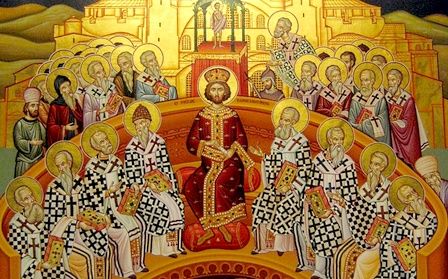
17. The next Jubilee will mark a very important anniversary for all Christians. It will be 1700 years since the first great ecumenical council, the Council of Nicaea, was celebrated. It’s worth recalling that, since apostolic times, pastors have repeatedly met in assembly to deal with doctrinal and disciplinary issues. In the first centuries of the faith, synods multiplied in both East and West, demonstrating the importance of preserving the unity of the People of God and fidelity to the proclamation of the Gospel. The Jubilee Year could be an important opportunity to concretize this synodal form that the Christian community today perceives as an increasingly necessary expression to better respond to the urgency of evangelization: all the baptized, each with his or her charism and ministry, co-responsible so that multiple signs of hope bear witness to God’s presence in the world.
The mission of the Council of Nicaea was to preserve the unity seriously threatened by the denial of the divinity of Jesus Christ and his equality with the Father. Some three hundred bishops were present, gathered in the imperial palace, convened by Emperor Constantine on May 20, 325. After various debates, they all agreed, by the grace of the Spirit, on the Symbol of faith that we still profess today in the Sunday celebration of the Eucharist. The fathers of the Council wanted to begin this Symbol by using the expression “We believe” for the first time. We believe, [ Nicene Symbol: H. Denzinger – A. Schönmetzer, Enchiridion Symbolorum definitionum et declarationum de rebus fidei et morum, n. 125. In this “We”, all the churches were in communion, and all Christians professed the same faith.
The Council of Nicaea is a milestone in the history of the Church. Its anniversary invites Christians to unite in praise and thanksgiving to the Holy Trinity, and in particular to Jesus Christ, the Son of God, “consubstantial with the Father[Ibid. . who revealed this mystery of love to us. But Nicaea also represents an invitation to all the Churches and ecclesial communities to pursue the path towards visible unity, never tiring of seeking the appropriate forms to respond fully to Jesus’ prayer: “That they may all be one, just as you, Father, are in me, and I in you. May they also be one in us, so that the world may believe that you sent me” (Jn 17:21).
The Council of Nicaea also discussed the date of Easter. Even today, there are still divergent positions that prevent the founding event of the faith from being celebrated on the same day. By a providential twist of fate, this will happen in 2025. This should be a call to all Christians, East and West, to take a decisive step towards unity around a common Easter date. It’s worth pointing out that many are no longer aware of the controversies of the past, and don’t understand how divisions can persist on this subject.
- Calls to hope
16. Echoing the ancient words of the prophets, the Jubilee reminds us that the earth’s goods are not for the privileged few, but for all. Those who possess wealth must be generous in recognizing the faces of their brothers and sisters in need. I’m thinking in particular of those who lack food and water: hunger is a scandalous wound in the body of our humanity, and it calls on everyone to awaken their conscience. I renew my appeal that“with the financial resources devoted to arms and other military expenditure, a World Fund be set up to eradicate hunger once and for all, and for the development of the poorest countries, so that their inhabitants do not resort to violent or deceptive solutions and do not need to leave their countries in search of a more dignified life. “. [ Lett. enc. Fratelli tutti, n. 262. ]
I’d like to issue another urgent invitation in view of the Jubilee Year: it’s addressed to the richest nations to recognize the seriousness of many of the decisions they have taken, and to decide to forgive the debts of countries that will never be able to repay them. It’s more a question of justice than magnanimity, aggravated today by a new form of iniquity of which we have become aware: “There is, in fact, a real “ecological debt”, particularly between North and South, linked to trade imbalances, with consequences in the ecological field, and also linked to the disproportionate use of natural resources, historically practiced by certain countries.”. [ Lett. enc. Laudato si’, n. 51. As Scripture teaches, the earth belongs to God, and we all live on it as guests and strangers (cf. Lev 25:23). If we really want to pave the way for peace in the world, let’s commit ourselves to remedying the root causes of injustice, clear unjust and insolvent debts, and feed the hungry.
“A very important anniversary for all Christians
will fall during the next Jubilee”.
- Anchored in hope
18. Together with faith and charity, hope forms the triptych of “theological virtues” that express the essence of the Christian life (cf. 1 Cor 13:13; 1 Thess 1:3). In their inseparable dynamism, hope is that which, so to speak, orients, indicates the direction and goal of the believer’s existence. This is why the apostle Paul invites us: “Have the joy of hope, stand firm in trial, be assiduous in prayer” (Rom 12:12). Yes, we must “overflow with hope”. (cf. Rom 15:13) to bear credible and attractive witness to the faith and love we hold in our hearts; so that faith is joyful, charity enthusiastic; so that everyone can give even a smile, a gesture of friendship, a fraternal glance, a sincere listening ear, a free service, knowing that, in the Spirit of Jesus, this can become a fruitful seed of hope for those who receive it. But what is the foundation of our hope? To understand this, we need to look at the reasons for our hope (cf. 1 Pet 3:15).
19. “I believe in eternal life” : [Symbol of the Apostles: H. Denzinger – A. Schönmetzer, Enchiridion Symbolorum definitionum et declarationum de rebus fidei et morum, n. 30. … so professes our faith. Christian hope finds in these words a fundamental pillar. It is in fact “the theological virtue by which we desire as happiness […] eternal Life”. [Catechism of the Catholic Church, n. 1817. ] The Second Vatican Ecumenical Council states: “When divine support and the hope of eternal life are lacking, man’s dignity suffers a very serious wound, as we often see today, and the enigma of life and death, of guilt and suffering, remains unresolved. And so, all too often, people sink into despair. “. [Const.
past. Gaudium et spes, n. 21. We, on the other hand, by virtue of the hope in which we have been saved, as we look at the passing of time, are certain that the history of humanity, and that of each individual, is not heading towards a dead end or an obscure abyss, but towards an encounter with the Lord of glory. So let us live in expectation of His return, and in the hope of living forever in Him. It is in this spirit that we make our own the moving invocation of the first Christians, with which Holy Scripture ends: “Come, Lord Jesus! (Rev 22:20).
20. Jesus dead and risen is the heart of our faith. St. Paul, by stating this content in a few words – with just four verbs – conveys to us the “core” of our hope: “First of all, I have passed on to you this, which I myself received: that Christ died for our sins in accordance with the Scriptures, and was laid in the tomb; that he rose again on the third day in accordance with the Scriptures, that he appeared to Peter, and then to the Twelve” ( 1 Co 15, 3-5). Christ died, was buried, rose and appeared. He went through the drama of death for us. The Father’s love resurrected him in the power of the Spirit, making his humanity the first fruits of eternity for our salvation. Christian hope consists precisely in this: in the face of death, where everything seems to end, we receive the certainty that, thanks to Christ, through his grace communicated to us in Baptism, “life is not destroyed, but transformed”.[Roman Missal
, Preface for the Dead I. forever. In Baptism, buried with Christ, we receive in Him, risen from the dead, the gift of new life that breaks down the wall of death and makes it a passageway to eternity.
And if no rhetoric is allowed in the face of death, a painful separation that forces us to leave our dearest affections behind, the Jubilee will offer us the opportunity to rediscover, with immense gratitude, the gift of this new life received in Baptism, capable of transfiguring the drama. It’s important to think again, in the context of the Jubilee, about how this mystery was understood from the earliest centuries of the faith. For a long time, for example, Christians built baptismal fonts in an octagonal shape, and even today we can admire many ancient baptisteries that retain this shape, such as in Rome’s San Giovanni di Latran. This indicates that, in the baptismal font, an eighth day is inaugurated, the day of the resurrection, the day that goes beyond the usual rhythm marked by the weekly deadline, thus opening up the cycle of time to the dimension of eternity, to life that lasts forever. This is the goal of our earthly pilgrimage (cf. Rom 6:22).
The most convincing testimony to this hope is offered by the martyrs who, firm in their faith in the Risen Christ, were able to renounce their lives here below so as not to betray their Lord. These confessors of the never-ending life are present in every age, and they are numerous in our own, perhaps more than ever. We need to keep their witness alive to make our hope fruitful.
These martyrs from different Christian traditions are also seeds of unity, as they express the ecumenism of blood. This is why I fervently hope that during the Jubilee there will be an ecumenical celebration, so that the richness of the witness of these martyrs can be highlighted.
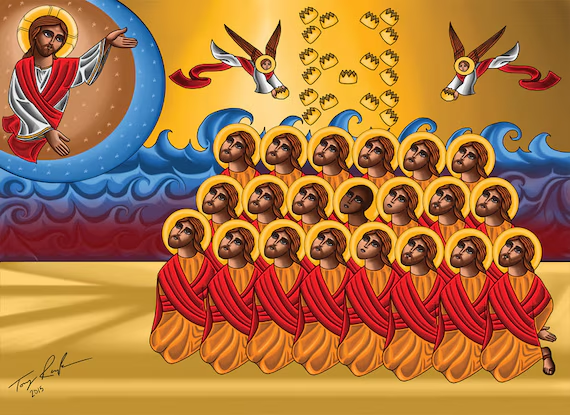
Icon of the 21 Coptic martyrs of Libya.
They make up a group of 21 Christians, 20 Egyptians – all workers, married and fathers for the majority – and a Ghanaian – a Muslim converted to Christ because of the striking testimony of faith of those who would become his “companions” in martyrdom – who were executed on February 15, 2015 on a beach in Sirte by militiamen of the Islamic State in Libya.
21. So what happens to us after death? With Jesus, beyond the threshold is eternal life, which consists in full communion with God, in contemplation and participation in his infinite love. What we experience today in hope, we will then see in reality. St. Augustine wrote on this subject: “When I am united to you with all my being, then there will be no more pain, no more work; my life will be all alive, being all full of you”. [Confessions,
X, 28.What will characterize this fullness of communion? Happiness. Happiness is the vocation of the human being, a goal that concerns everyone.
But what is happiness? What kind of happiness do we expect and desire? Not a fleeting joy, an ephemeral satisfaction that, once attained, demands ever more in a spiral of covetousness where the human soul is never satiated but always emptier. We need a happiness that is definitively fulfilled in that which fulfills us, that is, in love, so that we can say, right now: I am loved, therefore I exist; and I will always exist in the Love that does not disappoint and from which nothing and no one can ever separate me. Let us recall again the words of the apostle: “Of this I am certain: neither death nor life, neither angels nor principalities in heaven, neither the present nor the future, neither powers nor heights nor depths, nor any other creature, can separate us from the love of God which is in Christ Jesus our Lord.” (Rom 8:38-39).
22. Another reality linked to eternal life is God’s judgment, both at the end of our existence and at the end of time. Art has often attempted to represent this – think of Michelangelo’s masterpiece in the Sistine Chapel – by adopting the theological conception of the time and conveying a sense of dread to the beholder. While it is right to prepare oneself conscientiously and seriously for the moment that recapitulates existence, we must at the same time always do so in the dimension of hope, a theological virtue that sustains life and enables us not to give in to fear. God’s judgment, which is love (cf. 1 Jn 4:8.16), can only be based on love, and in particular on whether or not we practice it towards those most in need, in whom Christ, the Judge in person, is present (cf. Mt 25:31-46). It is therefore a judgment different from that of men and earthly courts. It must be understood as a relationship of truth with God-love and with oneself in the unfathomable mystery of divine mercy. Sacred Scripture affirms in this regard: “By your example you have taught your people that the just must be human; to your sons you have given a beautiful hope: after the fault you grant conversion […] and [nous comptons] on your mercy when we are judged.” ( Wis 12, 19.22). As Benedict XVI wrote: “At the moment of judgment, we experience and welcome the domination of his love over all evil in the world and in ourselves. The suffering of love becomes our salvation and our joy. [ Lett.
enc. Spe salvi, n. 47. ]
Judgment, then, is about the salvation we hope for, and which Jesus obtained for us through his death and resurrection. It is therefore intended to open us up to the ultimate encounter with Him. And since, in this context, the evil committed cannot be allowed to remain hidden, it needs to be purified to allow the definitive passage into God’s love. In this sense, we understand the need to pray for those who have completed their earthly journey, the solidarity in prayerful intercession that draws its efficacy from the communion of saints, from the common bond that unites us in Christ, the first-born of creation. In this way, the Jubilee Indulgence, in virtue of prayer, is intended in a special way for those who have gone before us, so that they may obtain full mercy.
23. Indulgence, in fact, enables us to discover just how unlimited God’s mercy is. It’s no coincidence that, in ancient times, the term “mercy” was used interchangeably with “indulgence”, precisely because the latter is intended to express the fullness of God’s forgiveness, which knows no limits.
The Sacrament of Penance assures us that God forgives our sins. The words of the psalm return with their consoling power: “He forgives all your trespasses and heals you of every disease; He claims your life from the grave and crowns you with love and tenderness; […] The Lord is tender and merciful, slow to anger and full of love; […] He does not act towards us according to our faults, nor repay us according to our trespasses. As heaven dominates the earth, so strong is His love for those who fear Him; as far as the east is from the west, He puts our sins far from us” (Ps 103, 3-4.8.10-12). Sacramental Reconciliation is not only a wonderful spiritual opportunity, it represents a decisive, essential and indispensable step on every person’s journey of faith. It is here that we allow the Lord to destroy our sins, heal our hearts, lift and embrace us, and make known to us his tender and compassionate face. Indeed, there is no better way to know God than to let ourselves be reconciled to Him (cf. 2 Cor 5:20), savoring His forgiveness. So let us not renounce Confession, but rediscover the beauty of the sacrament of healing and joy, the beauty of the forgiveness of sins!
However, as we know from personal experience, sin “leaves traces”, it entails consequences: not only external insofar as they are the consequences of the evil committed, but also internal, insofar as “every sin, even venial, entails an unhealthy attachment to creatures, which needs purification either here below, or after death in the state we call purgatory”. [Catechism
of the Catholic Church, n. 1472. In our weak humanity, attracted by evil, there remain “residual effects of sin”. These are eliminated by indulgence, always through the grace of Christ, who is, as Saint Paul VI wrote, “our “indulgence””. [ Lett. ap. Apostolorum limina, May 23 1974, II. ] The Apostolic Penitentiary will publish provisions for obtaining and making effective the practice of the Jubilee Indulgence.
Such an experience of forgiveness can only open the heart and mind to forgive. Forgiveness does not change the past, nor can it alter what has already happened. But forgiveness does enable us to change the future, and to live differently, without rancor, resentment or vengeance. A future illuminated by forgiveness enables us to read the past with different, more serene eyes, even if they are still clouded with tears.
During the last Extraordinary Jubilee, I instituted the Missionaries of Mercy, who continue to fulfill an important mission. May they exercise their ministry in the coming Jubilee too, restoring hope and forgiving whenever a sinner comes to them with an open heart and a repentant soul. May they continue to be instruments of reconciliation, and help us to look to the future with the hope of the heart that comes from the Father’s mercy. I hope that the bishops will be able to take advantage of their precious service, in particular by sending them to places where hope is put to the test, such as prisons, hospitals and places where the dignity of the person is violated, in the most destitute situations and contexts of greatest distress, so that no one is deprived of the possibility of welcoming God’s forgiveness and consolation.
24. Hope finds its greatest witness in the Mother of God. In her, we see that hope is not a vain optimism, but a gift of grace in the realism of life. Like any mother, every time she looked at her Son, she thought of his future, and certainly in her heart remained engraved the words Simeon had addressed to her in the temple: “Behold, this child will cause the fall and rise of many in Israel. He will be a sign of contradiction, and your soul will be pierced by a sword”. (Lk 2:34-35). And at the foot of the cross, as she saw the innocent Jesus suffer and die, though overcome by immense suffering, she repeated her “yes”, without losing hope or confidence in the Lord. In this way, she collaborated for us in the fulfillment of what her Son had said, announcing “that the Son of Man must suffer many things, that he must be rejected by the elders, the chief priests and the scribes, that he must be killed, and that three days later he must rise again”. (Mk 8:31). And in the torment of this pain offered out of love, she became our Mother, the Mother of hope. It’s no coincidence that popular piety continues to invoke the Blessed Virgin as Stella Maris, a title that expresses the sure hope that, in the stormy vicissitudes of life, the Mother of God comes to our aid, sustains us and invites us to trust and keep on hoping.
In this connection, I’d like to remind you that the Shrine of Our Lady of Guadalupe in Mexico City is preparing to celebrate the 500th anniversary of the first apparition of the Virgin Mary in 2031. Through the young Juan Diego, the Mother of God sent a revolutionary message of hope, which she still repeats today to all pilgrims and faithful: “Am I not here, I who am your mother?” [Nican Mopohua, n. 119] A similar message is imprinted in the hearts of many Marian shrines around the world, the destinations of countless pilgrims who confide their worries, sorrows and hopes to the Mother of God. In this Jubilee Year, shrines must be holy places of welcome, and privileged spaces for fostering hope. I invite pilgrims coming to Rome to stop and pray in the city’s Marian shrines, to venerate the Virgin Mary and invoke her protection. I’m sure that everyone, especially those who suffer and are afflicted, will be able to experience the closeness of the most affectionate of mothers, who never abandons her children, and who is for the holy People of God “a sign of assured hope”. “a sign of sure hope and consolation”.. [Second Vatican Ecumenical Council, Dogmatic Constitution Lumen gentium, n. 68].

25. As we head towards the Jubilee, let us return to Sacred Scripture and listen to these words addressed to us: “This is a strong encouragement to us who have sought refuge in the hope offered to us and which we have grasped. This hope we hold as a sure and firm anchor for the soul; it enters beyond the curtain, into the Sanctuary where Jesus entered for us as a forerunner”. (Heb 6:18-20). It’s a powerful invitation to never lose the hope we’ve been given, to cling to it and take refuge in God.
The image of the anchor evokes the stability and security we possess in the midst of life’s turbulent waters if we trust in the Lord Jesus. The storms can never wash it away, because we are anchored in the hope of grace, which is able to make us live in Christ, triumphing over sin, fear and death. This hope, far greater than daily satisfactions and improved living conditions, carries us beyond the trials and pushes us to walk without losing sight of the greatness of the goal to which we are called, Heaven.
The coming Jubilee will therefore be a Holy Year characterized by the hope that does not pass away, the hope that is in God. May it also help us to rediscover the confidence needed in the Church and in society, in interpersonal relations, in international relations, in the promotion of the dignity of every person and in respect for creation. May our witness of faith be a leaven of authentic hope in the world, a proclamation of the new heavens and the new earth (cf. 2 Pet 3:13), where we will dwell in justice and harmony between peoples, striving towards the fulfillment of the Lord’s promise.
Let’s allow ourselves to be drawn to hope today, and let’s make it contagious through us, for those who desire it. May our lives say to them: “Hope in the Lord, be strong and take courage; hope in the Lord” (Ps 27:14). May the strength of hope fill our present, in confident expectation of the return of the Lord Jesus Christ, to whom be praise and glory, now and for ever.
Given in Rome, at St. John Lateran, on May 9, Solemnity of the Ascension of Our Lord Jesus Christ in the year 2024, the twelfth of my Pontificate.
François
